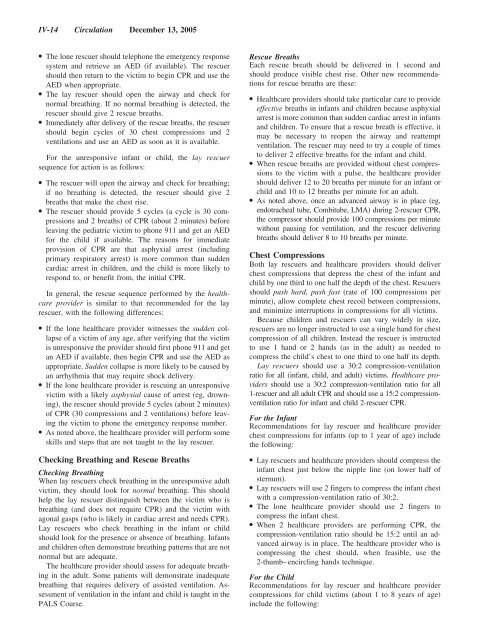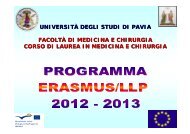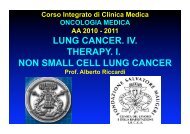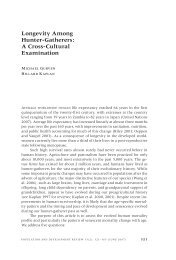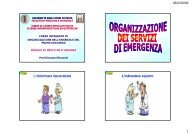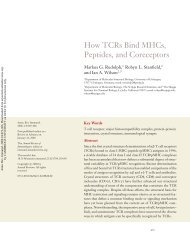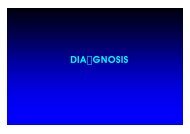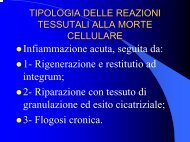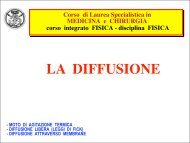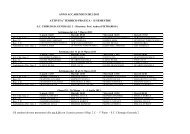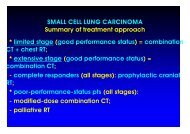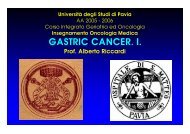Overview of CPR
Overview of CPR
Overview of CPR
Create successful ePaper yourself
Turn your PDF publications into a flip-book with our unique Google optimized e-Paper software.
IV-14 Circulation December 13, 2005<br />
● The lone rescuer should telephone the emergency response<br />
system and retrieve an AED (if available). The rescuer<br />
should then return to the victim to begin <strong>CPR</strong> and use the<br />
AED when appropriate.<br />
● The lay rescuer should open the airway and check for<br />
normal breathing. If no normal breathing is detected, the<br />
rescuer should give 2 rescue breaths.<br />
● Immediately after delivery <strong>of</strong> the rescue breaths, the rescuer<br />
should begin cycles <strong>of</strong> 30 chest compressions and 2<br />
ventilations and use an AED as soon as it is available.<br />
For the unresponsive infant or child, the lay rescuer<br />
sequence for action is as follows:<br />
● The rescuer will open the airway and check for breathing;<br />
if no breathing is detected, the rescuer should give 2<br />
breaths that make the chest rise.<br />
● The rescuer should provide 5 cycles (a cycle is 30 compressions<br />
and 2 breaths) <strong>of</strong> <strong>CPR</strong> (about 2 minutes) before<br />
leaving the pediatric victim to phone 911 and get an AED<br />
for the child if available. The reasons for immediate<br />
provision <strong>of</strong> <strong>CPR</strong> are that asphyxial arrest (including<br />
primary respiratory arrest) is more common than sudden<br />
cardiac arrest in children, and the child is more likely to<br />
respond to, or benefit from, the initial <strong>CPR</strong>.<br />
In general, the rescue sequence performed by the healthcare<br />
provider is similar to that recommended for the lay<br />
rescuer, with the following differences:<br />
● If the lone healthcare provider witnesses the sudden collapse<br />
<strong>of</strong> a victim <strong>of</strong> any age, after verifying that the victim<br />
is unresponsive the provider should first phone 911 and get<br />
an AED if available, then begin <strong>CPR</strong> and use the AED as<br />
appropriate. Sudden collapse is more likely to be caused by<br />
an arrhythmia that may require shock delivery.<br />
● If the lone healthcare provider is rescuing an unresponsive<br />
victim with a likely asphyxial cause <strong>of</strong> arrest (eg, drowning),<br />
the rescuer should provide 5 cycles (about 2 minutes)<br />
<strong>of</strong> <strong>CPR</strong> (30 compressions and 2 ventilations) before leaving<br />
the victim to phone the emergency response number.<br />
● As noted above, the healthcare provider will perform some<br />
skills and steps that are not taught to the lay rescuer.<br />
Checking Breathing and Rescue Breaths<br />
Checking Breathing<br />
When lay rescuers check breathing in the unresponsive adult<br />
victim, they should look for normal breathing. This should<br />
help the lay rescuer distinguish between the victim who is<br />
breathing (and does not require <strong>CPR</strong>) and the victim with<br />
agonal gasps (who is likely in cardiac arrest and needs <strong>CPR</strong>).<br />
Lay rescuers who check breathing in the infant or child<br />
should look for the presence or absence <strong>of</strong> breathing. Infants<br />
and children <strong>of</strong>ten demonstrate breathing patterns that are not<br />
normal but are adequate.<br />
The healthcare provider should assess for adequate breathing<br />
in the adult. Some patients will demonstrate inadequate<br />
breathing that requires delivery <strong>of</strong> assisted ventilation. Assessment<br />
<strong>of</strong> ventilation in the infant and child is taught in the<br />
PALS Course.<br />
Rescue Breaths<br />
Each rescue breath should be delivered in 1 second and<br />
should produce visible chest rise. Other new recommendations<br />
for rescue breaths are these:<br />
● Healthcare providers should take particular care to provide<br />
effective breaths in infants and children because asphyxial<br />
arrest is more common than sudden cardiac arrest in infants<br />
and children. To ensure that a rescue breath is effective, it<br />
may be necessary to reopen the airway and reattempt<br />
ventilation. The rescuer may need to try a couple <strong>of</strong> times<br />
to deliver 2 effective breaths for the infant and child.<br />
● When rescue breaths are provided without chest compressions<br />
to the victim with a pulse, the healthcare provider<br />
should deliver 12 to 20 breaths per minute for an infant or<br />
child and 10 to 12 breaths per minute for an adult.<br />
● As noted above, once an advanced airway is in place (eg,<br />
endotracheal tube, Combitube, LMA) during 2-rescuer <strong>CPR</strong>,<br />
the compressor should provide 100 compressions per minute<br />
without pausing for ventilation, and the rescuer delivering<br />
breaths should deliver 8 to 10 breaths per minute.<br />
Chest Compressions<br />
Both lay rescuers and healthcare providers should deliver<br />
chest compressions that depress the chest <strong>of</strong> the infant and<br />
child by one third to one half the depth <strong>of</strong> the chest. Rescuers<br />
should push hard, push fast (rate <strong>of</strong> 100 compressions per<br />
minute), allow complete chest recoil between compressions,<br />
and minimize interruptions in compressions for all victims.<br />
Because children and rescuers can vary widely in size,<br />
rescuers are no longer instructed to use a single hand for chest<br />
compression <strong>of</strong> all children. Instead the rescuer is instructed<br />
to use 1 hand or 2 hands (as in the adult) as needed to<br />
compress the child’s chest to one third to one half its depth.<br />
Lay rescuers should use a 30:2 compression-ventilation<br />
ratio for all (infant, child, and adult) victims. Healthcare providers<br />
should use a 30:2 compression-ventilation ratio for all<br />
1-rescuer and all adult <strong>CPR</strong> and should use a 15:2 compressionventilation<br />
ratio for infant and child 2-rescuer <strong>CPR</strong>.<br />
For the Infant<br />
Recommendations for lay rescuer and healthcare provider<br />
chest compressions for infants (up to 1 year <strong>of</strong> age) include<br />
the following:<br />
● Lay rescuers and healthcare providers should compress the<br />
infant chest just below the nipple line (on lower half <strong>of</strong><br />
sternum).<br />
● Lay rescuers will use 2 fingers to compress the infant chest<br />
with a compression-ventilation ratio <strong>of</strong> 30:2.<br />
● The lone healthcare provider should use 2 fingers to<br />
compress the infant chest.<br />
● When 2 healthcare providers are performing <strong>CPR</strong>, the<br />
compression-ventilation ratio should be 15:2 until an advanced<br />
airway is in place. The healthcare provider who is<br />
compressing the chest should, when feasible, use the<br />
2-thumb–encircling hands technique.<br />
For the Child<br />
Recommendations for lay rescuer and healthcare provider<br />
compressions for child victims (about 1 to 8 years <strong>of</strong> age)<br />
include the following:


